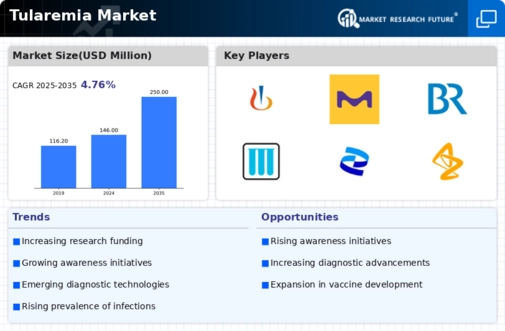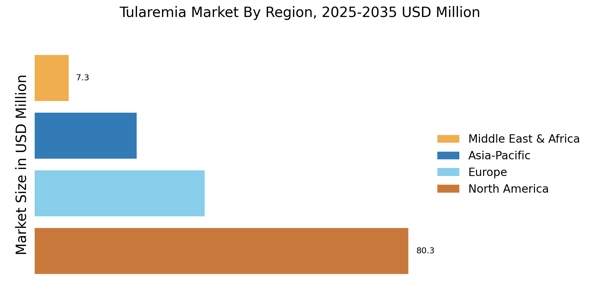Rising Incidence of Tularemia Cases
The increasing incidence of tularemia cases is a primary driver for the Tularemia Market. Reports indicate that the number of reported cases has been on the rise, particularly in regions where the disease is endemic. This uptick in cases necessitates enhanced diagnostic and therapeutic solutions, thereby propelling market growth. The Centers for Disease Control and Prevention has noted that tularemia is often underreported, suggesting that actual incidence rates may be higher than documented. As awareness of the disease grows, healthcare providers are more likely to seek out effective treatments and diagnostic tools, further stimulating the Tularemia Market. The need for effective public health strategies to manage and control outbreaks also contributes to the demand for innovative solutions in this sector.
Growing Awareness of Zoonotic Diseases
The growing awareness of zoonotic diseases, including tularemia, is driving the Tularemia Market. As public health campaigns highlight the risks associated with zoonotic infections, there is an increased focus on prevention and control measures. This heightened awareness leads to greater demand for educational resources, diagnostic tools, and treatment options. Additionally, veterinarians and healthcare providers are becoming more vigilant in recognizing and reporting cases of tularemia, which may contribute to an increase in diagnosed cases. The emphasis on zoonotic diseases in public health discussions suggests that the Tularemia Market will continue to expand as stakeholders seek effective solutions to address these health threats. The interconnectedness of human and animal health further underscores the importance of addressing tularemia within the broader context of zoonotic disease management.
Advancements in Diagnostic Technologies
Technological advancements in diagnostic tools are significantly influencing the Tularemia Market. The development of rapid and accurate diagnostic tests allows for quicker identification of tularemia, which is crucial for effective treatment. Innovations such as polymerase chain reaction (PCR) assays and serological tests have improved the speed and accuracy of diagnosis, leading to better patient outcomes. As healthcare systems increasingly adopt these advanced technologies, the demand for diagnostic products in the Tularemia Market is expected to rise. Furthermore, the integration of artificial intelligence in diagnostic processes may enhance the efficiency of identifying tularemia cases, thereby expanding the market. The ongoing research into novel diagnostic methods indicates a promising future for the Tularemia Market.
Regulatory Support for Vaccine Development
Regulatory support for vaccine development is emerging as a crucial driver for the Tularemia Market. As the need for effective vaccines against tularemia becomes more apparent, regulatory agencies are streamlining the approval processes for vaccine candidates. This support encourages pharmaceutical companies to invest in research and development of tularemia vaccines, which could significantly alter the landscape of disease prevention. The potential for a successful vaccine not only addresses public health concerns but also opens new avenues for market growth. The collaboration between regulatory bodies and research institutions is likely to foster innovation in vaccine technology, thereby enhancing the Tularemia Market. As vaccine candidates progress through clinical trials, the anticipation surrounding their potential approval may further stimulate interest and investment in this sector.
Increased Funding for Infectious Disease Research
Increased funding for infectious disease research is a significant driver for the Tularemia Market. Governments and private organizations are allocating more resources to combat infectious diseases, including tularemia. This funding supports research initiatives aimed at understanding the disease better and developing effective treatments and vaccines. For instance, the National Institutes of Health has prioritized research on zoonotic diseases, which includes tularemia, thereby enhancing the focus on this area. The influx of financial resources not only accelerates the pace of research but also encourages collaboration among academic institutions, pharmaceutical companies, and public health organizations. As a result, the Tularemia Market is likely to benefit from a surge in innovative products and solutions aimed at managing and preventing the disease.


















Leave a Comment